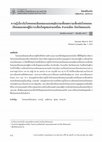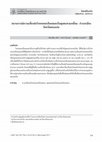Papers by Deunphen Srikha

Journal of Medical Technology and Physical Therapy วารสารเทคนิคการแพทย์และกายภาพบำบัด, Dec 4, 2012
Stroke is one of the important causes of disability and death of Thai people. The best management... more Stroke is one of the important causes of disability and death of Thai people. The best management method for stroke is prevention by providing health education, especially to persons with risk of stroke. This study aimed to explore the knowledge on the stroke and behaviors to reduce the risk of stroke among risk persons in Samliam community, Nai Mueang Sub-district, Mueang District, Khon Kaen Province. One hundred and forty-four chronic disease patients with risk of stroke identified by the criteria of the Ministry of Public Health (99 women and 45 men, mean age 64.3 ± 9.5 years) were interviewed about their knowledge and behaviors about stroke. Data were analysed by using descriptive statistics. The study was conducted from January until June 2011. The results revealed that 52.8 % and 76.4 % of the participants had high levels of knowledge on the stroke and behaviors to reduce the risk of stroke, respectively. However, some participants had inappropriate knowledge on warning signs of stroke and nutritional behaviors. These findings could be useful for the primary care unit to specify a strategy of health education and behavioral change activities to persons with risk of stroke for developing Samliam community towards a stroke-free community. In addition, the may be useful for other communities which have a similar context.

Journal of Medical Technology and Physical Therapy วารสารเทคนิคการแพทย์และกายภาพบำบัด, 2011
Stroke is one of the important causes of disability and death of Thai people. The best management... more Stroke is one of the important causes of disability and death of Thai people. The best management method for stroke is prevention. This study was aimed to explore the situation of risk of stroke in Samliam community, Muang District, Khon Kaen Province. Two hundred and ninety-three persons with hypertension, diabetes, and hyperlipidemia (196 women and 97 men, mean age 62.5 + 10.7 years) of Samliam primary care unit were recruited. The participants' risks of stroke were assessed using an assessment form designed by the Ministry of Public Health. The results showed that 39.6% and 37.5% of participants were identified as persons with high and medium-high risk levels, respectively. Meanwhile, only 22.9% were classified as no stroke risk group. These findings could be useful for the Samliam primary care unit and others with similar context to specify a strategy of health education and behavioral change activities for their people towards a goal of stroke-free community.

Srinagarind Medical Journal ศรีนครินทร์เวชสาร, Jun 24, 2013
Background and objective: Caring for palliative patients at home is a hard work. Relative caregiv... more Background and objective: Caring for palliative patients at home is a hard work. Relative caregiver sometimes become burnout. Community volunteers play an alternative role in community-based palliative care. The aim of this study was to explore the perceptions from village health volunteers in a community of Khon Kaen Province about community-based palliative care by volunteers. Methods: This was a qualitative research among the village health volunteers in Samleum 1 community of Khon Kaen Province. The total number was 27. For processing of data collection, the in-depth interview and focus group discussion were performed to elicit village health volunteer's perceptions about community-based palliative care. The data was collected between March 2012 and May 2012. Content analysis was done. Results: This study revealed that their perceptions about community-based palliative care were divided into three issues. 1) View point of village health volunteers about community-based palliative care were home visits for canvass, encourage, patients' care and advise. 2) Barriers include knowledge incompetence, lack of patients' trust, patient or their relative expressed dissatisfaction with the village health volunteers' home visit and village health volunteers did not have time enough to care palliative patients at home. 3) Explicit needs include knowledge and นิ พนธ์ ต้ นฉบั บ • Original Article
Uploads
Papers by Deunphen Srikha